We are visual creatures. We understand things visually. This, in part, makes the Trinity - one God, three Persons - so difficult for us to comprehend. How can two or more things occupy the same space without losing their distinction? It's basic physics!
Most of us have seen the baseball diamond-looking picture that is meant to help us with this concept.

We may be able to articulate the idea of the Trinity, but the imagery is still problematic for us.
This is where Begbie has a wonderful insight. He suggests that music can benefit theology by better illustrating audibly what is so limiting visually. We're talking more than appropriately matching words to music, though that is certainly of great importance.
Take the doctrine of the Trinity, for example. The most basic chord is called a triad, and it is made up of 3 notes (tri - triad - Trinity...just checkin'!). Take away one note, and it is no longer a triad. To play the chord, all three notes must be played at once. It is one chord, but it is made up of 3 distinct notes. You don't hear one note, and then another, and then another. This wouldn't be a chord, but an arpeggio, or broken chord. You don't percieve one note in the chord to the exclusion of the other two, either. Three equal notes, one triad.
In Begbie's own words from Beholding the Glory:
"What could be more apt than to speak of the Trinity as a three-note-resonance of life, mutually indwelling, without mutual exclusion and yet without merger, each occupying the same ‘space,’ yet recognizably and irreducibly distinct, mutually enhancing and establishing each other? To speak of three strings mutually resonating instantly introduces a dynamism ... far truer to the trinitarian, living God of the New Testament.”
So simple, yet so amazing, isn't it?
Whoa. That's brilliant . . . and a far better analogy than an apple with with seeds and a steam or an egg with a shell and a yolk or whatever other hokey analogies Sunday School teachers have made up over the centuries. I'm passing this along to Kantor Reuning!
ReplyDeleteThat's a wonderful analogy! I understood it better when you explained it than the quote though.
ReplyDelete